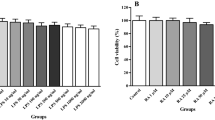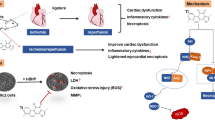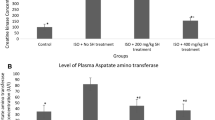Abstract
Oxidative stress and inflammation are considered as therapeutic targets in myocardial injury. The aim of the present study was to investigate the protective effect of syringic acid (SA) and syringaldehyde (SYD) on peripheral blood mononuclear cells (PBMCs) of myocardial infarction (MI) patients. PBMCs from MI patients were cultured in the presence and absence of SA and SYD. The level of tumor necrosis factor-α (TNF-α), interleukin-6 (IL-6), and nitric oxide (NO) was estimated. Reactive oxygen species (ROS) formation, oxidation of lipids, proteins, and activity of antioxidant enzymes were also quantified. To further determine biomolecular changes in treated PBMCs, Fourier transform infrared (FTIR) spectroscopic analysis was done. Molecular docking study was also conducted to evaluate the binding interaction of SA and SYD with various target proteins. SA and SYD treated PBMCs of MI patients showed decreased secretion of TNF-α, IL-6, and NO. Moreover, the content of ROS, level of lipid, and protein oxidation showed diminution by treatment with both the compounds. Enhanced antioxidant defense was also observed in treated PBMCs. The FTIR spectra of treated cells revealed safeguarding effect of SA and SYD on biomolecular structure. The molecular docking analysis displayed significant binding affinity of the two compounds towards TNF-α, IL-6, and antioxidant enzymes. Our findings demonstrated potent antioxidant and anti-inflammatory effects of SA and SYD on PBMCs of MI patients. Thus, SA and SYD supplementation might be beneficial in attenuating oxidative stress and inflammation in MI.











Similar content being viewed by others
References
Li H, Xie YH, Yang Q, Wang SW, Zhang BL, Wang JB, Cao W, Bi LL, Sun JY, Miao S, Hu J, Zhou XX, Qiu PC (2012) Cardioprotective effect of paeonol and danshensu combination on isoproterenol-induced myocardial injury in rats. PLoS One 7:e48872
Kurian GA, Rajagopal R, Vedantham S, Rajesh M (2016) The role of oxidative stress in myocardial ischemia and reperfusion injury and remodeling: revisited. Oxidative Med Cell Longev 2016
Hensley K, Robinson KA, Gabbita SP, Salsman S, Floyd RA (2000) Reactive oxygen species, cell signaling, and cell injury. Free Radic Biol Med 28:1456–1462
Sinisalo J, Paronen J, Mattila KJ, Syrjälä M, Alfthan G, Palosuo T, Nieminen MS, Vaarala O (2000) Relation of inflammation to vascular function in patients with coronary heart disease. Atherosclerosis 149:403–411
Kohsaka S, Menon V, Lowe AM, Lange M, Dzavik V, Sleeper LA, Hochman JS, SHOCK Investigators (2005) Systemic inflammatory response syndrome after acute myocardial infarction complicated by cardiogenic shock. Arch Intern Med 165:1643–1650
Dobaczewski M, Xia Y, Bujak M, Gonzalez-Quesada C, Frangogiannis NG. CCR5 signaling suppresses inflammation and reduces adverse remodeling of the infarcted heart, mediating recruitment of regulatory T cells. Am J Pathol 2010; 176:2177–2187. [PubMed: 20382703]
Güven M, Aras AB, Topaloğlu N, Özkan A, Şen HM, Kalkan Y, Okuyucu A, Akbal A, Gökmen F, Coşar M (2015) The protective effect of syringic acid on ischemia injury in rat brain. Turk J Med Sci 45:233–240
Kumar S, Prahalathan P, Raja B (2012) Syringic acid ameliorates (L)-NAME-induced hypertension by reducing oxidative stress. Naunyn Schmiedeberg's Arch Pharmacol 385:1175–1184
Muthukumaran J, Srinivasan S, Venkatesan RS, Ramachandran V, Muruganathan U (2013) Syringic acid, a novel natural phenolic acid, normalizes hyperglycemia with special reference to glycoprotein components in experimental diabetic rats. Journal of Acute Disease 2(4):304–309
Tanaka T, Kawaguchi N, Zaima N, Moriyama T, Fukuta Y, Shirasaka N (2017) Antiosteoporotic activity of a syringic acid diet in ovariectomized mice. J Nat Med 71(4):632–641
Shen CC, Ni CL, Shen YC, Huang YL, Kuo CH, Wu TS, Chen CC (2009) Phenolic constituents from the stem bark of Magnolia officinalis. J Nat Prod 72:168–171
Friedman M, Henika PR, Mandrell RE (2003) Antibacterial activities of phenolic benzaldehydes and benzoic acids against Campylobacter jejuni, Escherichia coli, Listeria monocytogenes, and Salmonella enterica. J Food Prot 10:1811–1821
Huang CH, Chen MF, Chung HH, Cheng JT (2012) Antihyperglycemic effect of syringaldehyde in streptozotocin-induced diabetic rats. J Nat Prod 75:1465–1468
Worm E, Beukelman CJ, Berg AJJ, Kroes BH, Labadie RP, Dijk H (2001) Effects of methoxylation of apocynin and analogs on the inhibition of reactive oxygen species production by stimulating human neutrophils. Eur J Pharmacol 433:225–230
Mossman T (1983) Rapid colorimetric assay for cellular growth and survival: application to proliferation and cytotoxicity assays. J Immunol Methods 65:55–63
Lowry OH, Rosebrough NJ, Farr AL, Randall RJ (1951) Protein measurement with the Folin phenol reagent. J Biol Chem 193:265–275
Miranda KM, Espey MG, Wink DA (2001) A rapid, simple spectrophotometric method for simultaneous detection of nitrate and nitrite. Nitric Oxide 5:62–71
Keller A, Mohamed A, Drose S, Brandt U, Fleming I, Brandes RP (2004) Analysis of dichloro dihydro fluorescein and dihydro calcein as probes for the detection of intracellular reactive oxygen species. Free Radic Res 38(12):1257–1267
Buege JA, Aust SD (1978) [30] Microsomal lipid peroxidation. Methods Enzymol 52: 302–310
Reznick AZ, Packer L (1994) [38] Oxidative damage to proteins: spectrophotometric method for carbonyl assay. Methods Enzymol 233: 357–363
Jollow D, Mitchell J, Na Z, Gillette J (1974) Bromobenzene-induced liver necrosis. Protective role of glutathione and evidence for 3, 4-bromobenzene oxide as the hepatotoxic metabolite. Pharmacology 11:151–169
Marklund S, Marklund G (1974) Involvement of the superoxide anion radical in the autoxidation of pyrogallol and a convenient assay for superoxide dismutase. Eur J Biochem 47:469–474
Claiborne A. Catalase activity, Handbook of methods for oxygen radical research, ed Greenwald R.A. (CRC Press, Boca Raton, FL). 1985
Flohé L, Günzler WA (1984) [12] Assays of glutathione peroxidase. Methods Enzymol 105: 114–120
Morris GM, Huey R, Linstrom W, Sanner MF, Belew RK, Goodsell DD, Olson AJ (2009) Valence bond theory for chemical dynamics. J Comput Chem 30:2785–2791
Morris GM, Goodsell DS, Halliday RS, Huey R, Hart WE, Belew RK, Olson AJ (1998) Design, synthesis and evaluation of genistein-polyamine conjugates as multi-functional anti-Alzheimer agents. J Comput Chem 19:1639–1662
Minhal Abidi M, Khan S, Ahmad S, Kausar T, Nayeem SM, Islam S, Ali A, Alam K, Moinuddin (2018) Biophysical and biochemical studies on glycoxidatively modified human low density lipoprotein. Archives of Biochemistry and Biophysics 645:87–99
Laskowski RA, Swindells MB (2011) LigPlot+: multiple ligand–protein interaction diagrams for drug discovery. J Chem Inf Model 51:2778–2786
Kiruthiga PV, Pandian SK, Devi KP (2010) Silymarin protects PBMC against B (a) P induced toxicity by replenishing redox status and modulating glutathione metabolizing enzymes—an in vitro study. Toxicol Appl Pharmacol 247(2):116–128
Mateen S, Rehman MT, Shahzad S, Naeem SS, Faizy AF, Khan AQ, Khan MS, Husain FM, Moin S (2019) Anti-oxidant and anti-inflammatory effects of cinnamaldehyde and eugenol on mononuclear cells of rheumatoid arthritis patients. Eur J Pharmacol 852:14–24
Sithuraj S, Viswanadha VP. Berbamine protects the heart from isoproterenol induced myocardial infarction by modulating eNOS and iNOS expressions in rats. Journal of Applied Biomedicine. 2018 Jun 7
Wollert KC, Drexler H (2002) Regulation of cardiac remodeling by nitric oxide, focus on cardiac myocyte hypertrophy and apoptosis. Heart Fail Rev 7:317–325
Musthafa QA, Abdul Shukor MF, Ismail NA, Mohd Ghazi A, Mohd Ali R, IF MN, Dimon MZ, Wan Ngah WZ (2017) Oxidative status and reduced glutathione levels in premature coronary artery disease and coronary artery disease. Free Radic Res 51(9–10):787–798
Shahzad S, Hasan A, Faizy AF, Mateen S, Fatima N, Moin S (2018) Elevated DNA damage, oxidative stress and impaired response defense system inflicted in patients with myocardial infarction. Clin Appl Thromb Hemost 24:780–789
Rajadurai M, Stanely Mainzen Prince P (2006) Preventive effect of naringin on lipids, lipoproteins and lipid metabolic enzymes in isoproterenol-induced myocardial infarction in wistar rats. J Biochem Mol Toxic 20:191–197
Hedayat M, Mahmoudi MJ, Rose NR, Rezaei N (2010) Pro-inflammatory cytokines in heart failure: double-edged swords. Heart Fail Rev 15(6):543–562
Eskandari V, Amirzargar AA, Mahmoudi MJ, Rahnemoon Z, Rahmani F, Sadati S, Rahmati Z, Gorzin F, Hedayat M, Rezaei N. Gene expression and levels of IL-6 and TNFα in PBMCs correlate with severity and functional class in patients with chronic heart failure. Irish Journal of Medical Science (1971-). 2018; 187(2):359–68
Shahzad S, Mateen S, Hasan A, Moin S (2019) GRACE score of myocardial infarction patients correlates with oxidative stress index, hsCRP and inflammation. Immunobiology. 224(3):433–439
Liu T, Zhang L, Joo D, Sun SC (2017) NF-κB signaling in inflammation. Signal transduction and targeted therapy 2:17023
Gao T, Ci Y, Jian H, An C. FTIR investigation of the interaction of tumor cells treated with caffeic acid and chlorogenic acid. Vibrational spectroscopy. 2000; 24 (2):225–31. OOR Kiruthiga PV, Pandian SK, Devi KP
Zelig U, Mordechai S, Shubinsky G, Sahu RK, Huleihel M, Leibovitz E, Nathan I, Kapelushnik J. Pre-screening and follow-up of childhood acute leukemia using biochemical infrared analysis of peripheral blood mononuclear cells. Biochimica et Biophysica Acta (BBA)-General Subjects. 2011 Sep 1; 1810(9):827–35
Balamurugan R, Stalin A, Ignacimuthu S (2012) Molecular docking of γ-sitosterol with some targets related to diabetes. Eur J Med Chem 47:38–43
Acknowledgments
The authors extend their sincere appreciation to the research facility provided by Chairperson, Department of Biochemistry, Department of Physiology, Jawaharlal Nehru Medical College and University Sophisticated Instrumentation Centre, Aligarh Muslim University.
Authors contribution statement
SS, S Moin, SM: conceived and designed research. SS: conducted experiments. TK, AH, SSN, MA, AFF: contributed new reagents and analytical tools. SS, S Moin, TK, SMN: analyzed data. SS: wrote the manuscript. All authors read and approved the manuscript.
Author information
Authors and Affiliations
Corresponding author
Ethics declarations
The study protocol was approved by the Institutional Ethics and Research Advisory Committee.
Conflict of interest
The authors declare that they have no competing interests.
Additional information
Publisher’s note
Springer Nature remains neutral with regard to jurisdictional claims in published maps and institutional affiliations.
Rights and permissions
About this article
Cite this article
Shahzad, S., Mateen, S., Kausar, T. et al. Effect of syringic acid and syringaldehyde on oxidative stress and inflammatory status in peripheral blood mononuclear cells from patients of myocardial infarction. Naunyn-Schmiedeberg's Arch Pharmacol 393, 691–704 (2020). https://doi.org/10.1007/s00210-019-01768-2
Received:
Accepted:
Published:
Issue Date:
DOI: https://doi.org/10.1007/s00210-019-01768-2




